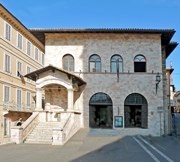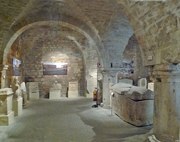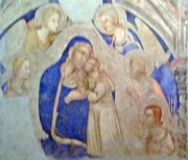


Palazzo delle Poste (1927) on the site of San Nicolò di Piazza
The Tabernacle of the Madonna del Popolo is to the left
The church of San Nicolò was first documented in 1097, and it was listed as a parish church in 1227.
In ca. 1207, soon after his conversion, the future St Francis went with Brother Bernard of Quintavalle (one of his earliest followers) to San Nicolò in order to discern how God would advise Brother Bernard on what to do with his possessions. He alighted upon three texts in succession, including the following: “If you would be perfect, go and sell what you have and give to the poor, and you shall have treasure in heaven’ (Matthew 19:21). Thus the Franciscan vocation was defined. The altar on which St Francis had consulted the Bible is now in the Cappella della Madonna del Pianto, San Rufino.
The church that St Francis knew had its main entrance in Via di San Paolo. A new facade with a portico and a campanile to the left was built in the Piazza in the 17th century. The church was badly damaged in the earthquake of 1832 and deconsecrated in 1848. It was subsequently used as a barracks until it was demolished in 1924 to make way for the Palazzo delle Poste (1927).

The surviving crypt (which is entered at number 2 Via Portica, to the left) was adapted in the 1930s to house the Museo Civico and to provide an entrance to the archaeological area.
Tabernacle of the Madonna del Popolo
The original tabernacle, which the Commune dedicated to the Virgin, was documented on what was then the side wall of San Nicolò di Piazza from the 14th century. It was used for public Masses and housed a fresco known as the Madonna del Popolo (see below). The tabernacle was demolished when the new facade was built in the 17th or 18th century.

Madonna del popolo (ca. 1318)


This fresco, which is usually attributed to an unknown follower of Simone Martini, originally depicted the Madonna and Child enthroned with SS Francis and Clare, who interceded for Assisi.
-
✴The lower part of it was largely destroyed, perhaps in the earthquake of 1832.
-
✴The upper part was rehoused in the new shrine on the façade of the Palazzo delle Poste in 1929. It was subsequently removed for restoration and moved, along with a fragment of the head of St Francis, to the Pinacoteca Comunale.
Art from the Church
Panels from San Nicolò di Piazza
Three panels that were removed from the church in 1832 are now in the Museo Diocesano:
-
✴St Nicholas of Bari (17th century)
-
This panel of the standing saint was documented in 1717 on the high altar of the church, with an attribution to Cesare Sermei. The document also attributed five frescoes in the presbytery, which depicted SS John the Baptist, John the Evangelist and the Cardinal Virtues, to Cesare Sermei but these were destroyed in the earthquake.
-
✴St Charles Borromeo in prayer (1612)
-
The inscription (which gives the date erroneously as 1512) records that Monaldo Vigilanti commissioned this panel in order to solicit the intercession of St Charles Borromeo for his blind nephew, Francesco. The boy is shown kneeling in prayer at the bottom left. The panel was documented in the 18th century on the Altare delle Reliquie, which belonged to the Confraternita di San Carlo Borromeo. The artist is unknown.
-
✴St Francis consulting the Bible in San Nicolò (ca. 1635)
-
This panel was documented in the 18th century on the Altare delle Reliquie, below the panel described above. It was presumably commissioned by the Petriccioli family, whose arms appear on the painted altar frontal: Bernardino Petriccioli, who died in 1635, left money in his will to support a chaplain for this altar, and his heirs may well have commissioned the panel. It depicts St Francis opening a bible at random in San Nicolò in order to discover his vocation, as described above.

